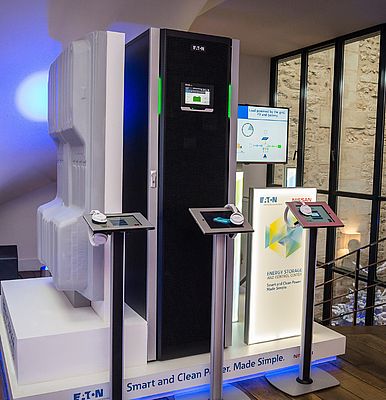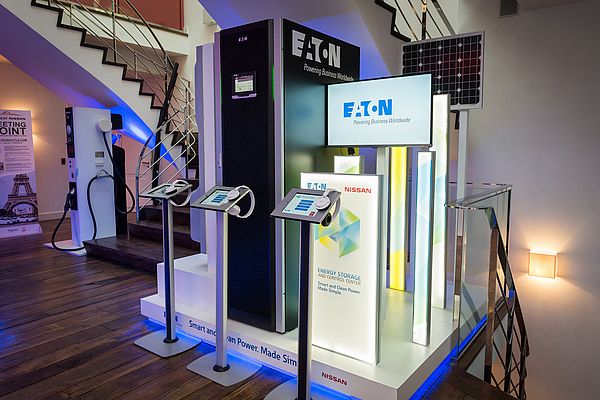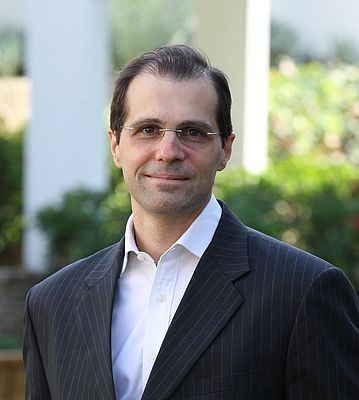2016 looks set to be the year of energy storage, as a growing number of suppliers commercialise battery technologies which are emerging as a critical part of the sustainable energy puzzle.
Tesla started the ball rolling, shipping deliveries of Powerwall, a home battery that charges using electricity generated from solar panels, or when utility rates are low, releasing its energy in the evening when demand and prices are higher. Other well-known companies such as Daimler have also launched products in this area.
At the same time, power management company Eaton has joined forces with carmaker Nissan and have developed an innovative and scalable energy storage and control system, opening up multiple applications across industrial, commercial and residential settings.
The Eaton/Nissan development is particularly interesting because it finds a way of giving a second-life to old batteries from electric cars. Specifically, the solution re-uses lithium-ion battery packs from Nissan’s Leaf electric vehicles, creating an energy storage technology with wide-ranging benefits including securing continuity of supply, integration of renewable energy sources, avoidance of peak energy tariffs, participation in demand response programs and a reduction in the reliance on expensive fuels such as diesel.
“Energy storage systems are becoming crucial components in the development of smarter grids,” said Cyrille Brisson, Vice President Marketing, Eaton Electrical EMEA. “These technologies facilitate the wider adoption and deployment of renewable generation, and they hold the potential to give people greater control over their energy supply and consumption.
“Each energy storage technology solution is different in its own way. But there are some common and wide-ranging benefits, which include continuity of supply, increased grid stability and efficiency, avoidance of peak energy tariffs and a reduction in the reliance on expensive fuels like diesel to compensate for no-grid or poor-grid situations. Energy storage clearly has a very bright future.”
From Nissan’s perspective, the energy storage technology provides a cost-effective ‘second life’ for batteries that have degraded after several years’ use in its Leaf vehicles. The Leaf has become one of the world’s top-selling all-electric cars, gaining acceptance as a popular replacement for petrol- and diesel-powered superminis and family runarounds, particularly in urban settings.
Second-life Leaf batteries maintain more than 70 percent of their initial capacity at the end of the ownership cycle, and with more than 200,000 Nissan EVs sold since launch, that represents multiple gigawatt hours of energy storage capacity.
The battery technology is combined with an uninterruptible power supply (UPS) from power management specialist Eaton, into a single, packaged system with the capability to integrate any solar PV system. This will allow customers to manage energy consumption and supply while connected to, or independent of, the grid.
The Eaton UPS acts as the brain of the system, with the second-life batteries providing the storage capacity. Importantly, the energy storage solution has been designed as an integrated package – unlike many other battery-based energy storage solutions currently available which comprise a collection of standalone technologies that are linked together.
With the integration of the photovoltaics, for example, the connection is not just via an input on the UPS - it is connected inside the UPS on the DC bus which acts to minimise the losses on the system. This integrated approach provides uninterrupted high-quality power, energy storage and supply of energy off-grid. The UPS is programmed to select the optimum mix of power sources according to load, grid constraints and availability of renewables.
In terms of usage, if installed with solar photovoltaics, the technology could work in several ways, depending on various factors. During early mornings, when renewable energy is not available and the batteries are not fully charged, the energy control centre could use the grid to power the load. When the sun begins to shine and renewable energy becomes available, the control centre could then be used to power load or charge the batteries.
When the sun is shining and batteries are fully charged, the energy control centre could feed the load directly with renewable energy, thereby reducing costs. During peak periods, when solar produces more energy than needed by the load, the control centre could inject the available energy to the grid. If grid demand was very high, the energy stored in the batteries could also be released to further support peak shaving.
The first working demonstration of the system was installed at the Nissan pavilion during the United Nations conference on climate change COP21 end of 2015 in central Paris. The system integrated power electronics, control software and stationary storage with the possibility to combine up to four 17 kWh second life batteries in parallel providing an output of up to 50 kW at voltages of 230V/400V. The building’s energy was switched from grid to batteries to power lighting and other electrical circuits. The technology is therefore tried and tested and ready for full market commercialisation.
In addition, Nissan’s new regional office in France will house the largest second life battery storage unit ever installed in a building, anywhere in the world. The new building will feature a 1 MWh energy storage system, from Eaton, powered by 64 Nissan Leaf second life EV batteries combined with solar energy generation.
In terms of system lifecycle, car battery capacity would usually degrade by around 25 percent over several years of standard automotive operation, and it is at this point that they would be considered for second-life energy storage use. Nissan says that, depending on their usage, the batteries in the energy storage unit would then be expected to last between five and 10 years.
Ultimately, the development of the energy storage product could change the economics of electric car ownership, as the value of degraded batteries increases. While disposal of spent batteries has always been considered a cost, in future there would be real value for the car owner at end of life. That change in the economic landscape could go a long way to transforming the market for electric cars.




























































